Ship Trajectory Classification Prediction at Waterway Confluences: An Improved KNN Approach
Abstract
1. Introduction
2. Proposed Method for Ship Trajectory Prediction
2.1. Ship Trajectory Data Preprocessing
2.1.1. AIS Data Cleaning
2.1.2. AIS Data Repairing
2.2. Ship Trajectory Data Clustering
2.3. Ship Trajectory Prediction
2.3.1. K-Nearest Neighbor Algorithm Considering the Sensitivity (SKNN)
2.3.2. Data Training of Ship Trajectory Prediction
3. Results and Discussion
3.1. Data Preprocessing Results
3.2. Analysis Effect of Clustering
3.3. Prediction Accuracy
3.3.1. Subtract the Length
3.3.2. Optimal k-Value for Comparing SKNN and KNN
3.3.3. Number of Training Samples
3.4. Discussion
4. Conclusions
Author Contributions
Funding
Institutional Review Board Statement
Informed Consent Statement
Data Availability Statement
Conflicts of Interest
References
- Kim, K.; Lee, D.; Essa, I. Gaussian process regression flow for analysis of motion trajectories. In Proceedings of the IEEE International Conference on Computer Vision, Barcelona, Spain, 6–13 November 2011. [Google Scholar]
- Qi, L. Ship Encounter Intention Identification and Navigation Aid Application in Intersection Waters. Master’s Thesis, Wuhan University of Technology, Wuhan, China, 2020. [Google Scholar]
- Ma, J.; Li, W.K.; Zhang, C.W.; Zhang, Y. Ship encounter situation recognition by processing AIS data from traffic intersection waters. Navig. China 2021, 44, 7. [Google Scholar]
- Cho, Y.; Han, J.; Kim, J. Intent inference of ship maneuvering for automatic ship collision avoidance. IFAC 2018, 51, 384–388. [Google Scholar] [CrossRef]
- Cho, Y.; Kim, J.; Kim, J. Intent Inference of Ship Collision Avoidance Behavior Under Maritime Traffic Rules. IEEE Access 2021, 9, 5598–5608. [Google Scholar] [CrossRef]
- Luo, Y.H. Ship Trajectory Prediction Based on AIS Data. Master’s Thesis, South China University of Technology, Guangzhou, China, 2017. [Google Scholar]
- Gao, D.W.; Zhu, Y.S.; Zhang, J.F.; He, Y.K.; Yan, K.; Yan, B.R. A novel MP-LSTM method for ship trajectory prediction based on AIS data. Ocean Eng. 2021, 228, 108956.1–108956.16. [Google Scholar] [CrossRef]
- Chen, Y.C. Research on Ship Trajectory Prediction Based on Data Mining. Harbin Engineering University, 2020. Master’s Thesis, South China University of Technology, Harbin, China, 2020. [Google Scholar]
- Wang, W.G.; Chu, X.M.; Jiang, Z.L.; Liu, L. Classification of Ship Trajectory Based on the Weighted Naive Bayes Algorithm. Navig. China 2020, 43, 20–25. [Google Scholar]
- Karata, G.B.; Karagoz, P.; Ayran, O. Trajectory pattern extraction and anomaly detection for maritime vessels. Internet Things 2021, 2021, 100436. [Google Scholar] [CrossRef]
- Zhang, L.Y.; Zhu, Y.A.; Lu, W.; Wen, J.; Cui, J.Y. A detection and restoration approach for vessel trajectory anomalies based on AIS. J. Northwestern Polytech. Univ. 2021, 39, 7. [Google Scholar] [CrossRef]
- Lee, J.G.; Han, J.; Whang, K.Y. Trajectory clustering: A partition-and-group framework. In Proceedings of the 2007 ACM SIGOD International Conference on Management of Data, Beijing, China, 20–25 June 2007. [Google Scholar]
- Rong, H.; Teixeira, A.P.; Soares, C.G. Data mining approach to shipping route characterization and anomaly detection based on ais Data. Ocean Eng. 2020, 198, 106936. [Google Scholar] [CrossRef]
- Gudmundsson, J.; Valladares, N. A GPU approach to subtrajectory clustering using the fréchet distance. IEEE Trans. Parallel Distrib. Syst. 2015, 26, 924–937. [Google Scholar] [CrossRef]
- Perera, L.P.; Oliveira, P.; Soares, C.G. Maritime traffic monitoring based on vessel detection, tracking, state estimation, and trajectory prediction. IEEE Trans. Intell. Transp. Syst. 2012, 13, 1188–1200. [Google Scholar] [CrossRef]
- Hu, Y.D.; Gao, C.S.; Li, J.L.; Jing, W.X.; Li, Z. Novel trajectory prediction algorithms for hypersonic gliding vehicles based on maneuver mode on-line identification and intent inference. Meas. Sci. Technol. 2021, 32, 115012. [Google Scholar] [CrossRef]
- Murray, B.; Perera, L.P. Ship behavior prediction via trajectory extraction-based clustering for maritime situation awareness. J. Ocean Eng. Sci. 2021, 7, 1–13. [Google Scholar] [CrossRef]
- Wang, L.X. Research on Ship Adaptive Trajectory Prediction and Application Based on GPR Model. Master’s Thesis, Wuhan University of Technology, Wuhan, China, 2019. [Google Scholar]
- Qian, L.; Zheng, Y.Z.; Li, L.; Ma, Y.; Zhou, C.H.; Zhang, D.F. A new method of inland water ship trajectory prediction based on long short-term memory network optimized by genetic algorithm. Appl. Sci. 2022, 12, 4073. [Google Scholar] [CrossRef]
- Tian, X.; Suo, Y. Research on Ship Trajectory Prediction Method Based on Difference Long Short-Term Memory. J. Mar. Sci. Eng. 2023, 11, 1731. [Google Scholar] [CrossRef]
- Gan, S.J.; Liang, S.; Li, K.; Deng, J. Ship trajectory prediction for intelligent traffic management using clustering and ANN. In Proceedings of the 2016 UKACC 11th International Conference on Control (CONTROL), Belfast, UK, 31 August–2 September 2016; pp. 1–6. [Google Scholar]
- Mehta, N. Ship Trajectory Prediction in Confined Waters. Master’s Thesis, Norwegian University of Science and Technology, Trondheim, Norway, 2023. [Google Scholar]
- Suo, Y.F.; Chen, W.K.; Claramunt, C.; Yang, S.H. A ship trajectory prediction framework based on a recurrent neural network. Sensors 2020, 20, 5133. [Google Scholar] [CrossRef]
- Zhao, J.S.; Yan, Z.W.; Zhou, Z.Z.; Chen, X.Q.; Wu, B.; Wang, S.Z. A ship trajectory prediction method based on GAT and LSTM. Ocean. Eng. 2023, 289, 116159. [Google Scholar] [CrossRef]
- Li, H.H.; Jiao, H.; Yang, Z.L. Ship trajectory prediction based on machine learning and deep learning: A systematic review and methods analysis. Eng. Appl. Artif. Intell. 2023, 126, 107062. [Google Scholar] [CrossRef]
- Li, H.H.; Jiao, H.; Yang, Z.L. AIS data-driven ship trajectory prediction modelling and analysis based on machine learning and deep learning methods. Transp. Res. Part E 2023, 175, 103152. [Google Scholar] [CrossRef]
- Zhou, Y.; Dong, Z.; Bao, X. A Ship Trajectory Prediction Method Based on an Optuna–BILSTM Model. Appl. Sci. 2024, 14, 3719. [Google Scholar] [CrossRef]
- Li, M.; Li, B.; Qi, Z.; Li, J.; Wu, J. Enhancing Maritime Navigational Safety: Ship Trajectory Prediction Using ACoAtt–LSTM and AIS Data. ISPRS Int. J. Geo-Inf. 2024, 13, 85. [Google Scholar] [CrossRef]
- Jiang, J.; Zuo, Y. Prediction of Ship Trajectory in Nearby Port Waters Based on Attention Mechanism Model. Sustainability 2023, 15, 7435. [Google Scholar] [CrossRef]
- Kasyk, L. Intensity of vessel traffic after crossing a waterway intersection. Reliab. Eng. Syst. Saf. 2007, 3, 2705–2708. [Google Scholar]
- Li, B.; Pang, F.W. An approach of vessel collision risk assessment based on the D-S evidence theory. Ocean Eng. 2013, 74, 16–21. [Google Scholar] [CrossRef]
- Maria, R.; Giuliana, P.; Michele, V. Maritime anomaly detection: A review. Wiley Interdiscip. Rev. Data Min. Knowl. Discov. 2018, 8, e1266. [Google Scholar]
- He, Y.X.; Jin, Y.; Huang, L.W.; Xiong, Y.; Chen, P.F.; Mou, J.M. Quantitative analysis of COLREG rules and seamanship for autonomous collision avoidance at open sea. Ocean Eng. 2017, 140, 281–291. [Google Scholar] [CrossRef]
- Chen, X.; Liu, S.; Zhao, J.; Wu, H.; Xian, J.; Montewka, J. Autonomous port management based AGV path planning and optimization via an ensemble reinforcement learning framework. Ocean Coast. Manag. 2024, 251, 107087. [Google Scholar] [CrossRef]
- Chen, X.; Lv, S.; Shang, W.l.; Wu, H.; Xian, J.; Song, C. Ship energy consumption analysis and carbon emission exploitation via spatial-temporal maritime data. Appl. Energy 2024, 360, 122886. [Google Scholar] [CrossRef]
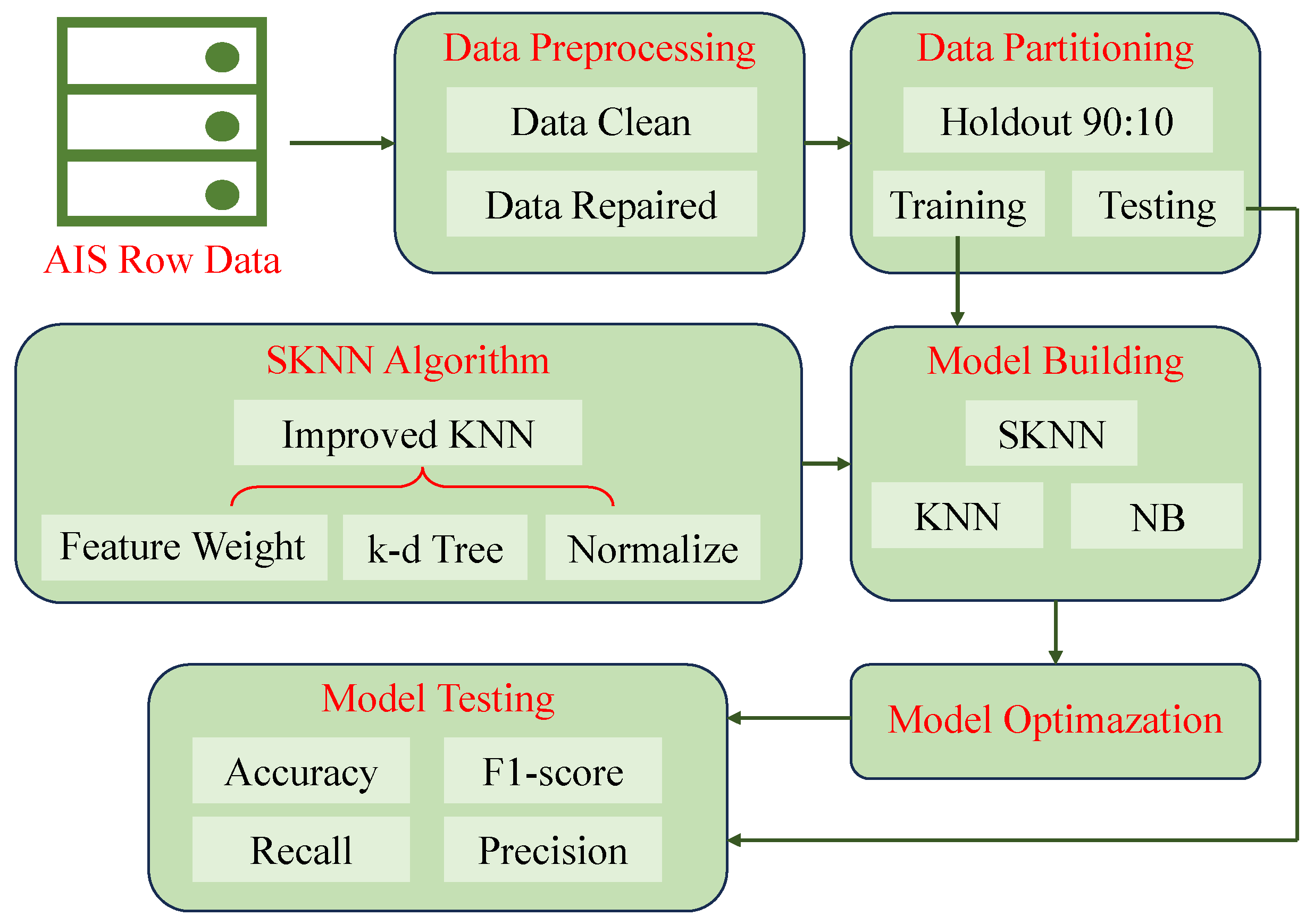

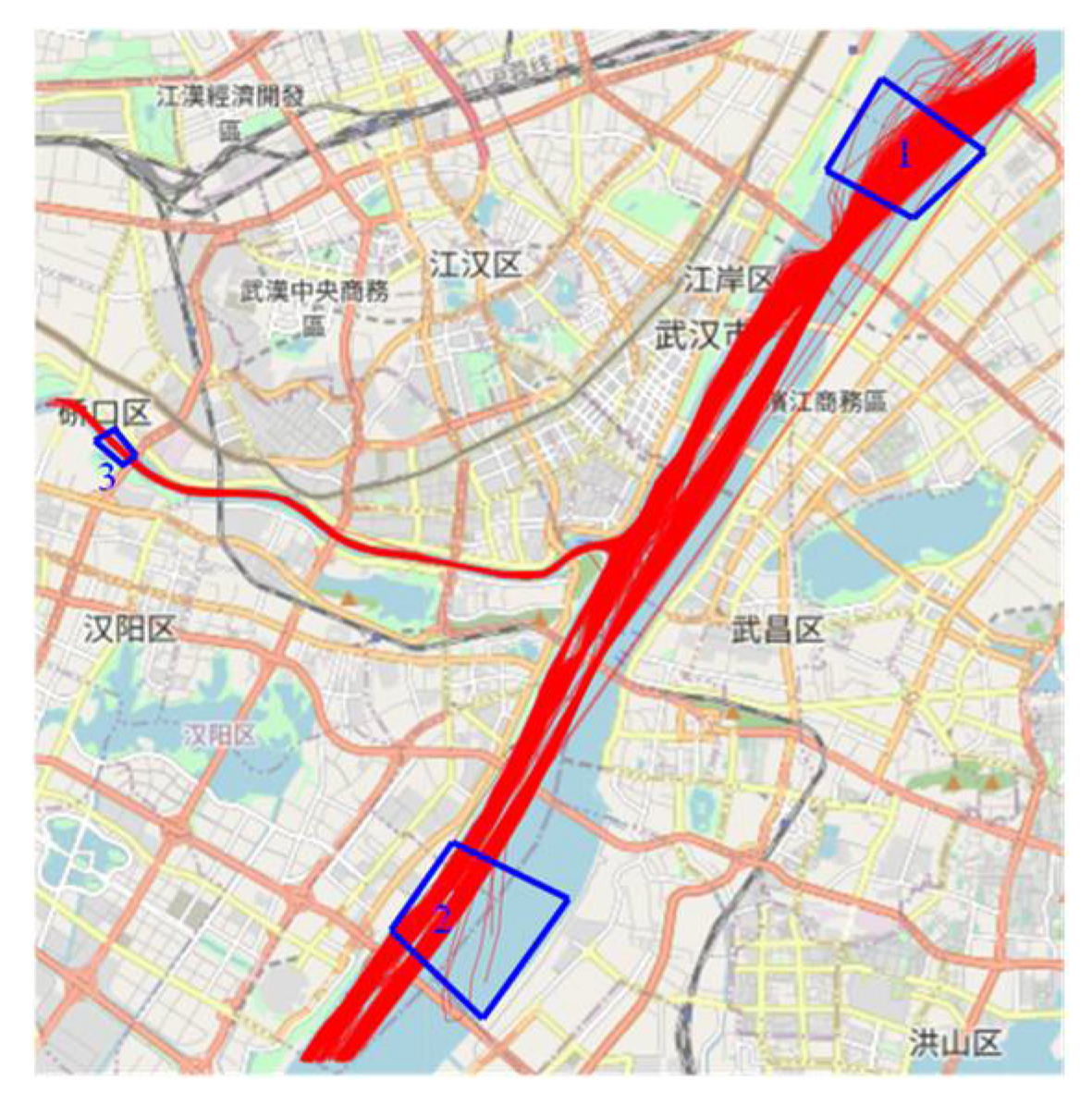

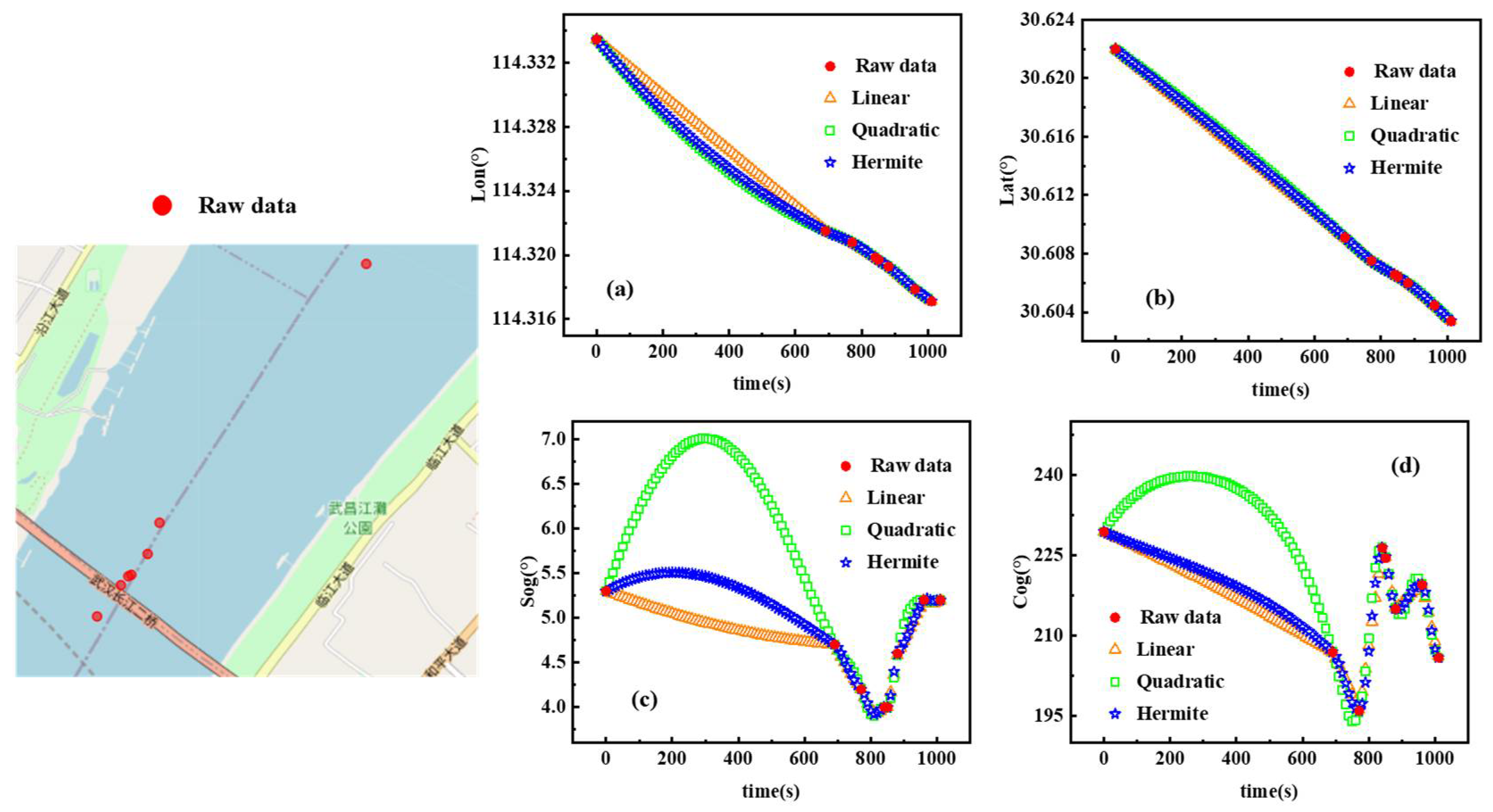
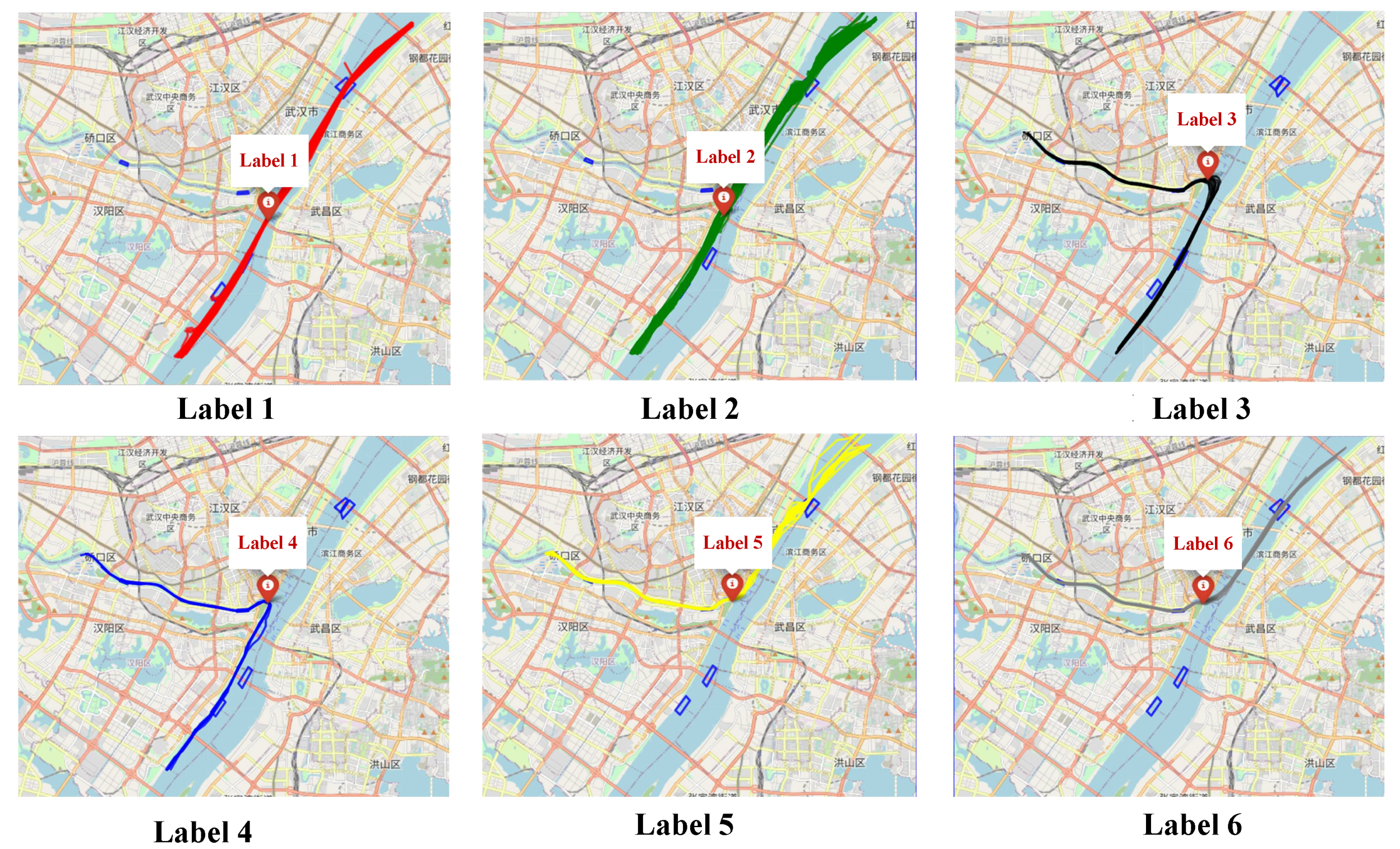

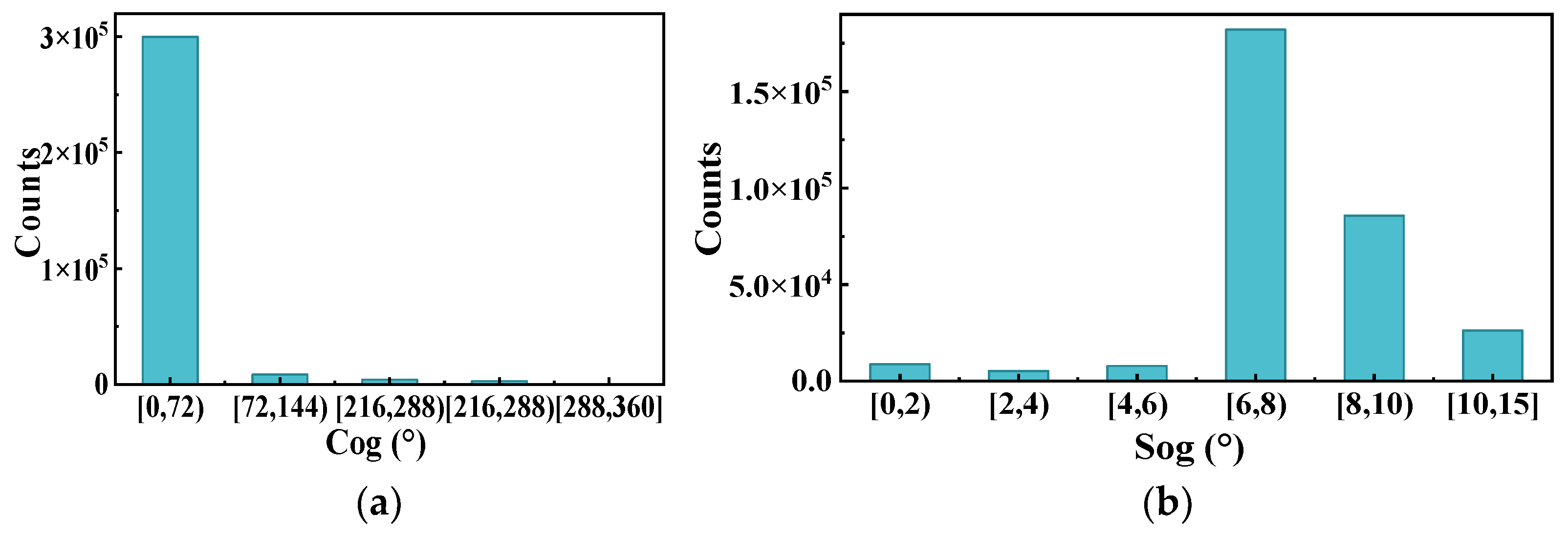
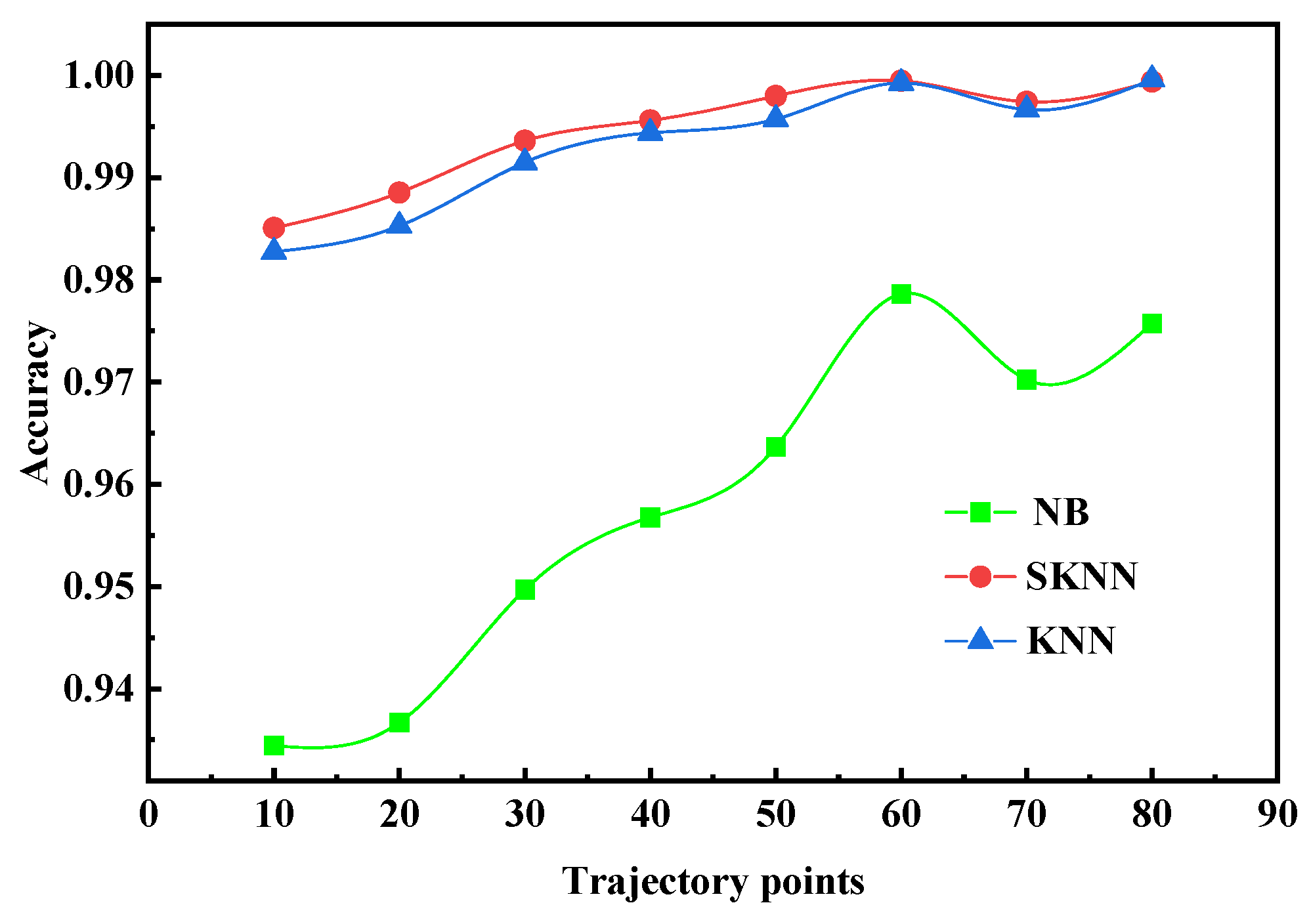
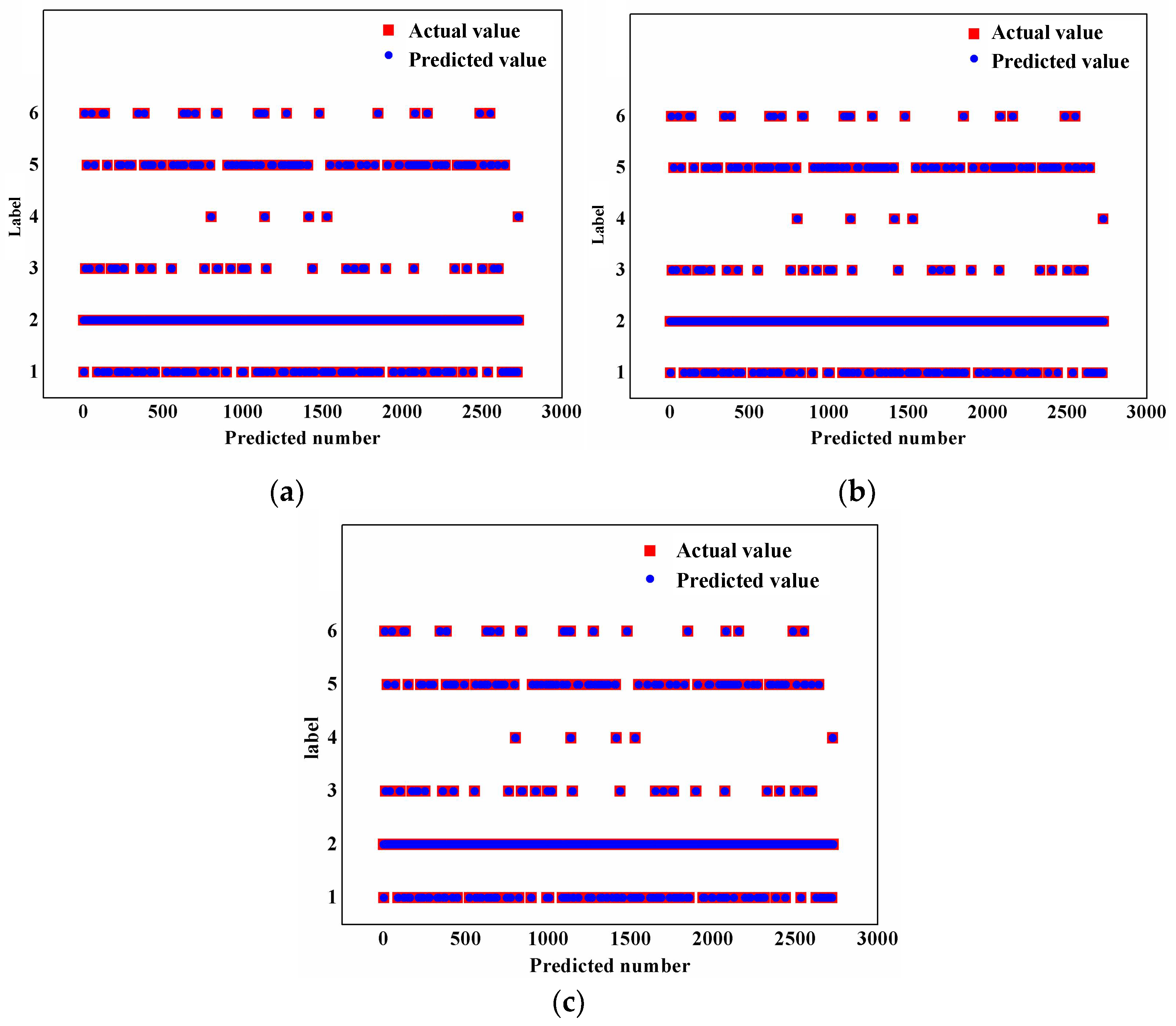
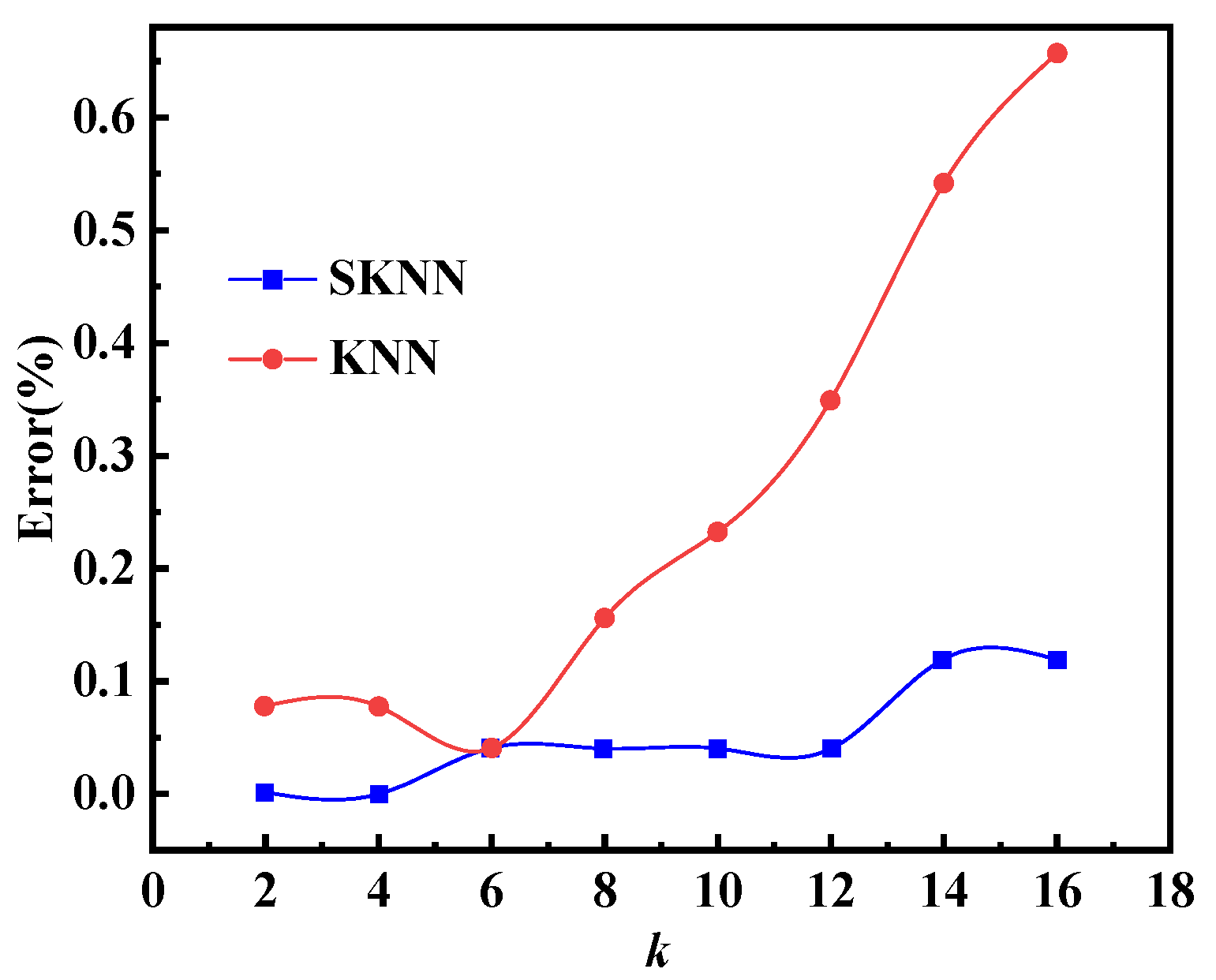
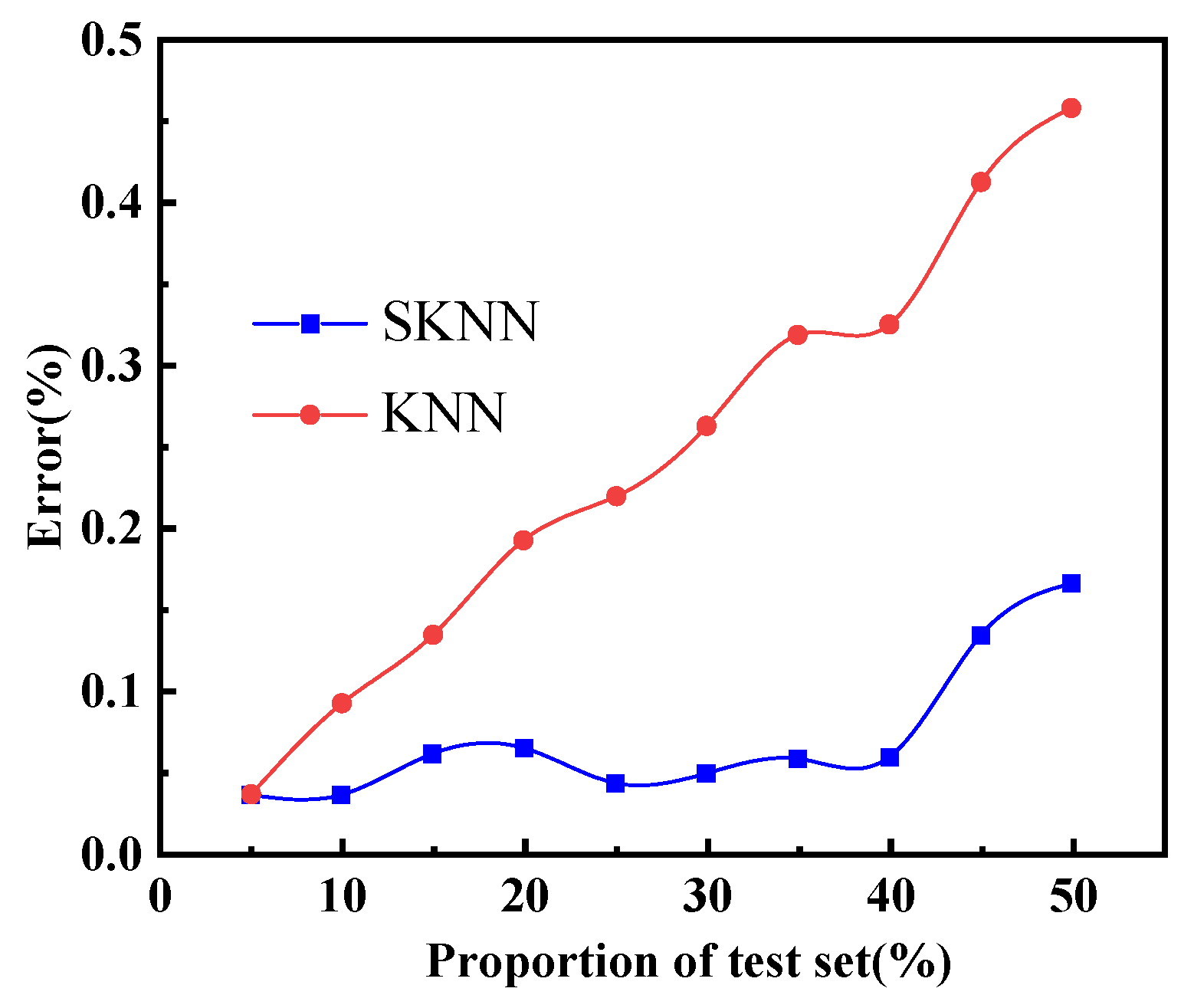
| Parameter | Data Type | Data Range |
|---|---|---|
| Time (t) | timestamp | 01/10/2020–30/11/2020 |
| MMSI | text | (200000000–799999999) Nine-digit integer |
| Longitude (x) | float | 0–180° |
| Latitude (y) | float | 0–90° |
| SOG (v) | float | 0–20 kn |
| Heading (θ) | float | 0–360° |
| Performance Metrics | SKNN | KNN | NB | |
|---|---|---|---|---|
| Macro avg | precision | 0.99 | 0.93 | 0.62 |
| recall | 0.99 | 0.87 | 0.72 | |
| F1-score | 0.99 | 0.9 | 0.64 | |
| Weighted avg | precision | 0.99 | 0.93 | 0.96 |
| recall | 0.99 | 0.92 | 0.94 | |
| F1-score | 0.99 | 0.92 | 0.95 |
Disclaimer/Publisher’s Note: The statements, opinions and data contained in all publications are solely those of the individual author(s) and contributor(s) and not of MDPI and/or the editor(s). MDPI and/or the editor(s) disclaim responsibility for any injury to people or property resulting from any ideas, methods, instructions or products referred to in the content. |
© 2024 by the authors. Licensee MDPI, Basel, Switzerland. This article is an open access article distributed under the terms and conditions of the Creative Commons Attribution (CC BY) license (https://creativecommons.org/licenses/by/4.0/).
Share and Cite
Wang, Z.; He, W.; Lan, J.; Zhu, C.; Lei, J.; Liu, X. Ship Trajectory Classification Prediction at Waterway Confluences: An Improved KNN Approach. J. Mar. Sci. Eng. 2024, 12, 1070. https://doi.org/10.3390/jmse12071070
Wang Z, He W, Lan J, Zhu C, Lei J, Liu X. Ship Trajectory Classification Prediction at Waterway Confluences: An Improved KNN Approach. Journal of Marine Science and Engineering. 2024; 12(7):1070. https://doi.org/10.3390/jmse12071070
Chicago/Turabian StyleWang, Zhiyuan, Wei He, Jiafen Lan, Chuanguang Zhu, Jinyu Lei, and Xinglong Liu. 2024. "Ship Trajectory Classification Prediction at Waterway Confluences: An Improved KNN Approach" Journal of Marine Science and Engineering 12, no. 7: 1070. https://doi.org/10.3390/jmse12071070
APA StyleWang, Z., He, W., Lan, J., Zhu, C., Lei, J., & Liu, X. (2024). Ship Trajectory Classification Prediction at Waterway Confluences: An Improved KNN Approach. Journal of Marine Science and Engineering, 12(7), 1070. https://doi.org/10.3390/jmse12071070







